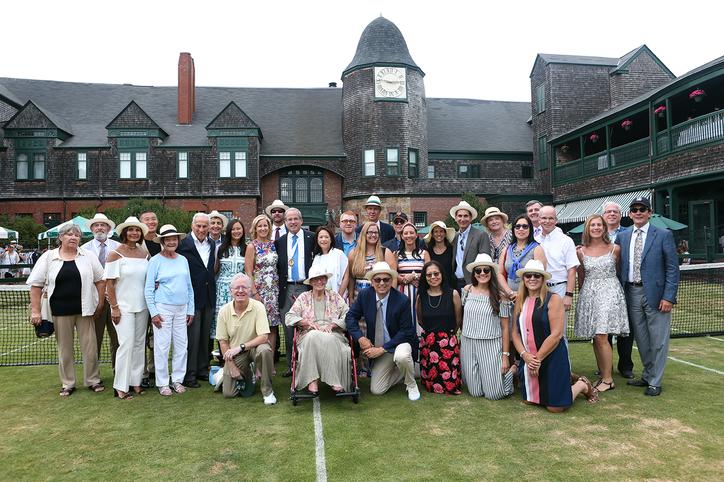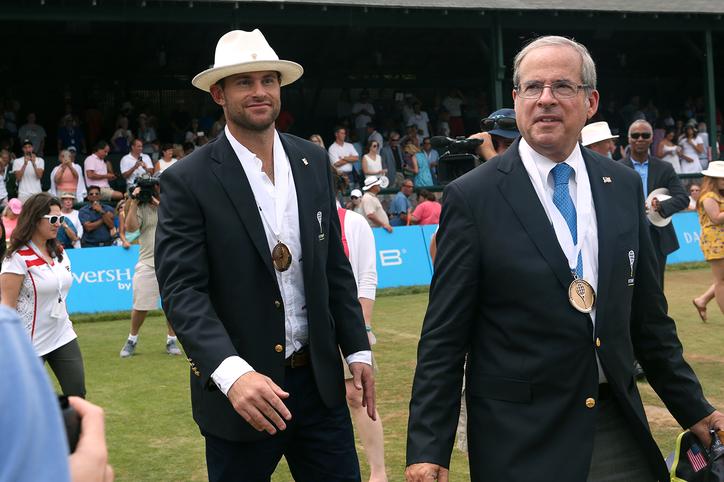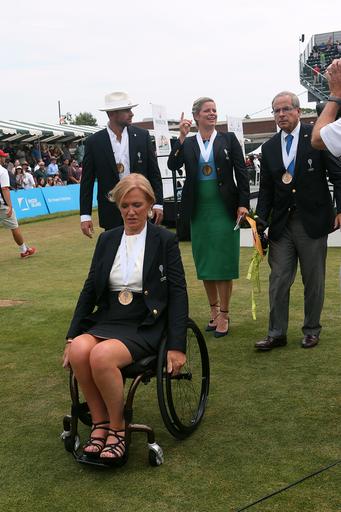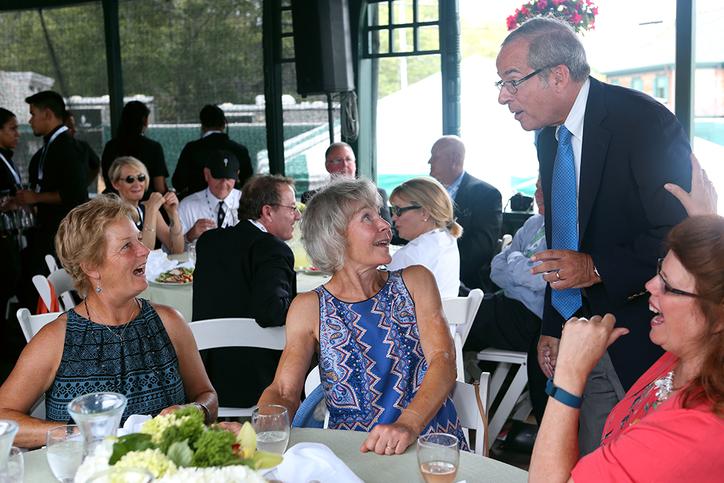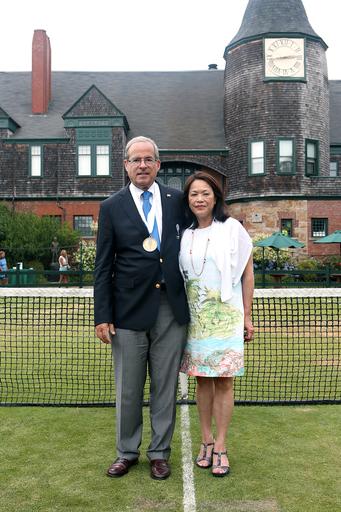Steve
Flink

- Biography
- Career Highlights
STEVE FLINK'S RELENTLESS PASSION
Players aren’t the only ones who know at a very young age that they want to throw their heart and soul into tennis.
Steve Flink first attended Wimbledon and the U.S. Championships in 1965, the summer he turned 13. The fortunate plot twist was that Flink lived in New York City and had a father based in London.
More than 50 years later, Flink could describe his early trips to those events – match details best of all – as clearly as if they had happened the previous day.
Among those who’d hooked the young Flink were a flock of future International Tennis Hall of Fame inductees, including the stylish Rafael Osuna, the bold Arthur Ashe, the composed Nancy Richey.
TEEN YEARS: THOROUGH OBESSSION
Flink’s summers instantly became anchored by Wimbledon and Forest Hills.
By age 15, Flink was dead certain that he wanted to become a tennis journalist. He would pursue this goal with the same laser-like focus of a player. A major centerpiece was the monthly arrival of the magazine World Tennis, then the sport’s bible, which Flink would devour instantly. Fueled by what he’d learned from World Tennis and other publications, Flink dove into all aspects of the sport – history, instruction, personalities, as well as playing the game himself. But most of all, there were the matches, Flink absorbing point after point with a brand of passion and engagement that cannot be taught. He was hooked. Tennis would be richer for it.
The year Flink turned 20, while still enrolled at the U.S. International University in Sussex, he began to help noted journalist Bud Collins as a statistician during CBS’ broadcast of the 1972 US Open, work he would soon do at many other tournaments for CBS, NBC and others. The next spring, at Roland Garros, an enterprising Flink conducted an interview with Chris Evert, selling the piece to World Tennis.
The spring of 1974 marked the beginning of Flink’s lengthy tenures at three of the sport’s preeminent media properties. Flink fit as comfortably at World Tennis as Rafael Nadal did at Roland Garros. He covered events, examined the game’s issues and personalities, assisted instructional editors such as Jack Kramer and Fred Stolle and built deep affinities with such notables as iconic designer-historian Ted Tinling, the ascending Evert and such journalists as New Yorker writer Herbert Warren Wind. Flink also during that time began more than 15 years of work with prominent historian John Barrett, each year authoring dozens of concise player biographies for Barrett’s comprehensive annual book, World of Tennis. All this research and writing was done long before computer databases and the Internet.
PRECISE PROSE
Rapidly, Flink earned the respect of players present and past as a source not just of data, but of deep knowledge and insight. Few who’ve covered tennis have so precisely articulated what happens inside the lines. From Flink’s World Tennis story on Jimmy Connors’ 1982 US Open win over Ivan Lendl: “Cognizant that Lendl much prefers to run around his backhand to blast his devastating reverse crosscourt forehand, Jimmy laced his favorite shot – the flat, two-handed crosscourt backhand – to force the Czech to play wide, running forehands that required more topspin. Lendl, who admitted to being ‘a little slow,’ couldn’t get set in time to unleash those lethal topspin drives and Connors continually rushed Ivan into mistakes.”
Flink held virtually every position at World Tennis, by 1990 becoming editor. A year later, when the magazine went out of business, he segued into work as a columnist for Gene Scott’s publication, Tennis Week. When Tennis Week folded 15 years later, Flink began to write a weekly on-line column for Tennis Channel. His work also extended to the broadcast world, including stints as an on-air analyst for ESPN, Madison Square Garden Network and CBS Radio.
FIRST-RATE MATE
Among his peers, Flink earned an impeccable reputation. Like tennis players, writers are in large part solo acts – ambitious, self-reliant, competitive, insular, even at times paranoid. But Flink was always exceptionally cordial, accessible and helpful. Hundreds of stories exist about journalists struggling to recall the details of a particular match, be it one that happened hours earlier or decades ago. And there was Flink, clad as always in blazer and tie, precisely aware. Evert won Roland Garros in 1985 with a backhand down-the-line pass. The rally that concluded the first set of the 1995 Pete Sampras-Andre Agassi US Open final lasted 22 shots. Don Budge only decided to come in on his service return at 4-3 in the fifth of his 1937 Davis Cup match versus Gottfried von Cramm. All of this Flink could conjure up instantly, with no need to check the Internet or any other materials.
GREAT BOOKS ARE MUST-READS
Flink’s command of decades of matches made him a natural to write two remarkable books – The Greatest Tennis Matches of the Twentieth Century (1999) and The Greatest Tennis Matches of All Time (2012). “He knows the game of tennis as well as anybody,” wrote Evert in her forward to the latter. “All through my career in the 1970s and 1980s, it caused much laughter between us when I would be asked a question about my record at a press conference. . . . In many cases, I would inaccurately recall an important detail about a match and Steve would have to interrupt me to set the record straight.”
Anyone seeking to understand the game’s history must read these two books. From Helen Wills to Serena Williams, Bill Tilden to Novak Djokovic, Flink examined the details of dozens of matches – strategies, key points, pivotal moments. Each tale also includes rich context, Flink providing insights into each player’s career both prior and after the notable match. Said Tennis Channel and NBC analyst Mary Carillo, “Its pages are brimming with insight, hindsight and, as always with Steve Flink, the 20/20 vision of the subtleties and complexities of a match . . . This book is a tennis treasure.”
Let the other journalists grow jaded. Never Steve Flink. More than 50 years after those first trips to Wimbledon and Forest Hills, Flink remains youthful, trekking into his seat to watch the tennis with trademark brio, élan and the small notepads that he uses to track the match at hand. After all, as every player knows, it’s best to take it one point at a time.
-- Joel Drucker, International Tennis Hall of Fame Historian-at-Large
Contributions to Tennis
- One of tennis's preeminent historians and journalists
- Lead columnist, tennischannel.com
- Author of two books
- Authored player portraits for historian John Barrett's annual book, World of Tennis
- On-air work for ESPN and MSG, more than 25 years as tennis correspondent for CBS Radio, and a statistician for ABC, CBS and NBC



















